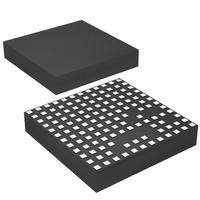LTM4611EV#PBF Linear Technology, LTM4611EV#PBF Datasheet - Page 14

LTM4611EV#PBF
Manufacturer Part Number
LTM4611EV#PBF
Description
IC UMODULE DC/DC LV 15A 133-LGA
Manufacturer
Linear Technology
Series
µModuler
Type
Point of Load (POL) Non-Isolatedr
Datasheet
1.LTM4611EVPBF.pdf
(28 pages)
Specifications of LTM4611EV#PBF
Output
0.8 ~ 5 V
Number Of Outputs
1
Power (watts)
75W
Mounting Type
Surface Mount
Voltage - Input
1.5 ~ 5.5 V
Package / Case
133-LGA
1st Output
0.8 ~ 5 VDC @ 15A
Size / Dimension
0.59" L x 0.59" W x 0.17" H (15mm x 15mm x 4.32mm)
Power (watts) - Rated
75W
Operating Temperature
-40°C ~ 125°C
Efficiency
94%
Lead Free Status / RoHS Status
Lead free / RoHS Compliant
3rd Output
-
2nd Output
-
Available stocks
Company
Part Number
Manufacturer
Quantity
Price
LTM4611
applicaTions inForMaTion
PLL, Frequency Adjustment and Synchronization
The default switching frequency of the LTM4611–with
PLLFLTR/f
PLLFLTR/f
pedance (>350kΩ) network. If desired, a resistor (R
can be connected from the PLLFLTR/f
to increase the switching frequency to as high as 780kHz,
nominally. Alternatively, R
from PLLFLTR/f
the switching frequency to as low as the minimum specified
value of 330kHz, nominally. In practical terms, however, be
advised that switching frequencies below 400kHz may be
of limited benefit due to the high inductor ripple currents
associated with that operating condition. See Figure 3.
There exists a fundamental trade-off between switch
mode DC/DC power conversion efficiency and switching
frequency: higher operating module switching frequency
enables the smallest overall solution size (minimized
output capacitance) for a given application; whereas,
lower switching frequency enables the highest efficiency
for a given application (to the extent that peak and RMS
inductor currents can be supported), but requires more
output capacitance to maintain comparable output voltage
ripple and noise characteristics.
The LTM4611 can be synchronized from 360kHz to 710kHz
with an input clock that has a high level above 2V and a
low level below 0.6V. Again in practical terms, be advised
that switching frequencies below 400kHz may be of limited
Figure 3. Relationship Between Oscillator Frequency,
PLLFLTR/f
Connection
1.50
1.37
1.23
1.09
0.96
0.82
0.68
0.55
0.41
2.05
1.91
1.78
1.64
SET
SET
0.1
VALUE OF RESISTOR ON PLLFLTR/f
SET
pin is driven to 1.23V through a high im-
left floating–is 500kHz, nominally. The
SET
Voltage, and External R
to signal ground (SGND) to decrease
1
fSET
SWITCHING FREQUENCY
PLLFLTR/f
R
TO GND
fSET
R
TO INTV
fSET
can instead be connected
CONNECTED
10
SET
CONNECTED
CC
SET
NOT USED
VOLTAGE
R
PIN (M )
fSET
ISET
SET
4611 F03
100
Value and
pin to INTV
600
550
500
450
400
350
300
250
200
800
750
700
650
fSET
CC
)
benefit due to the high inductor ripple currents associated
with that operating condition. See the Typical Applications
section for synchronization examples. The LTM4611 mini-
mum on-time is limited to 90ns. Guardband the on-time
to 130ns. The on-time can be calculated as:
Output Voltage Tracking and Soft-Start Functions
Output voltage tracking can be programmed externally
using the TRACK/SS pin. The output can be tracked up
and down with another regulator. The master regulator’s
output is divided down with an external resistor divider
that is the same as the slave regulator’s feedback divider
to implement coincident tracking. The LTM4611 uses an
accurate 60.4k resistor internally for the top feedback resis-
tor. Figure 4 shows an example of coincident tracking.
V
V
reference voltage. When the master’s output is divided
down with the same resistor values used to set the slave’s
output, then the slave will coincident track with the master
until it reaches its final value. The master will continue
to its final value from the slave’s regulation point. Volt-
age tracking is disabled when V
R
tracking.
The TRACK/SS pin of the master can be controlled by an
external ramp or the soft-start function of that regulator
can be used to develop that master ramp. The LTM4611 can
be used as a master by setting the ramp rate on its track
pin using a soft-start capacitor. A 1.4µA current source
is used to charge the soft-start capacitor. The following
equation can be used:
TRACK
TRACK
TA
t
V
t
ON(MIN)
SOFTSTART
OUT _ SLAVE
in Figure 4 will be equal to the R
is the track ramp applied to the slave’s track pin.
has a control range of 0V to 0.8V, or the internal
=
FREQ
= 0.8V •
1
= 1+
•
V
60.4k
R
V
OUT
FB2
IN
1.4µA
C
SS
• V
TRACK
TRACK
is more than 0.8V.
FB2
for coincident
4611f













